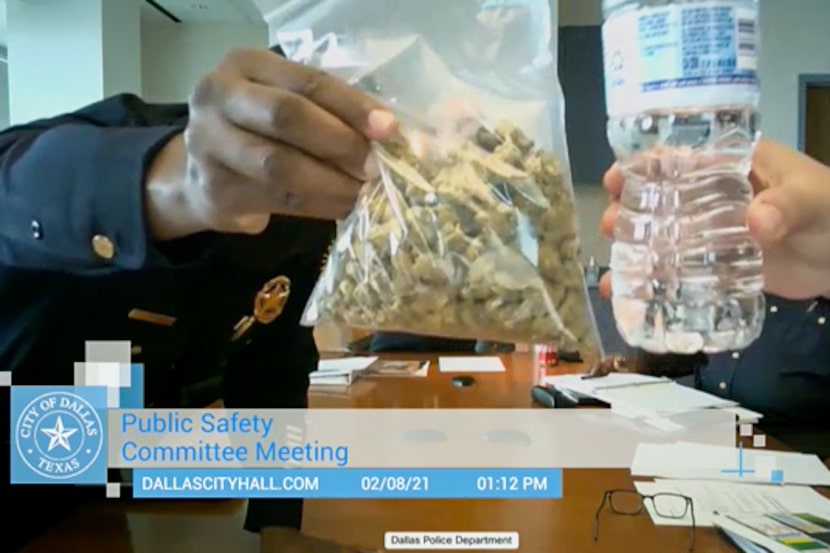A bag of marijuana is held up during Dallas Police Chief Eddie Garcia’s first public safety committee meeting as chief, which was held virtually, in Dallas on Monday, Feb. 8, 2021.(City of Dallas)
This November, Dallas voters will decide on the fate of a proposed amendment to the city charter that instructs the Dallas Police Department to not arrest or issue a citation for anyone possessing 2 to 4 ounces of marijuana (a Class A misdemeanor) or less than 2 ounces (a Class B misdemeanor). Advocates argue that it will reduce crime and lower criminal justice expenditures because fewer citations and arrests would ensue. They also assert it will increase state taxation revenue and improve public health because it is less harmful than alcohol.
Marijuana (cannabis) is a psychoactive drug. It contains chemicals that can alter mood, consciousness, cognition (thinking, attention, language, learning, memory and perception) and behavior. It contains more than 400 substances, but it is the chemical tetrahydrocannabinol (THC) that is responsible for the euphoria, sedative and analgesic effects. Synthetic cannabinoids such as “spice” or “K2″ are much more intense and their effects last longer, sometimes for days. They have a greater propensity for life-threatening toxicity.
Let’s examine the arguments.
Police Chief Eddie García refuted the “it will lower crime” statement by saying 4 ounces is a lot of marijuana, the amount drug dealers often possess to divide into 113 “dime bags.” This is not a “personal use amount.” This will prosper drug dealers and further degrade our most vulnerable, at-risk neighborhoods. Do we really want to allow dealers to sell marijuana a block or two from our schools undeterred by the threat of arrest?
Yes, states that have legalized marijuana initially saw an increase in tax revenue. But drug dealers are already criminals, so it is not surprising that the black market has continued to flourish in spite of legalization and there has yet to be an accounting of the added societal costs. For example, in 2021, Colorado reported a 140% increase in traffic fatalities where the driver tested positive for a cannabinoid. Marijuana impairs the ability to judge time, distance and speed, and this results in a slowed reaction time and a reduced ability to track moving objects. Horrendous accidents ensue.
While the harm caused by chronic alcohol abuse is well known, it is quite different from the pathophysiologic changes induced by cannabis use. This is not the place to do a side-by-side comparison, but suffice it to say that the harm done to the brain of chronic cannabis use is of a different type and possibly of faster onset than that of chronic alcohol abuse. Testing of teens and young adults who use it at least weekly demonstrates significant impairment of “neurocognitive function,” that is the ability to learn, to process information, to remember and memorize and to make appropriate decisions about daily living. With the passage of time their intelligence quotient (IQ) drops more than that seen in the non-users control group.
MRI studies of the brain provide physical evidence that correlates well with these behavioral findings by demonstrating shrinkage in several critical areas of the brain. For example, the section of the brain called the hippocampus shrivels, a part that plays a crucial role in learning, processing of emotions, decision-making and spatial navigation.
Additional deleterious changes to the body include an increased risk for heart attack and stroke in daily users, a 30% reduction in sperm counts and increased chance of testicular cancer in men, and an increased risk of delivering a premature infant of lower birth weight in pregnant women. Oh, and 10% of users become chronically addicted to it.
Exemplary achievement in school and at work is already challenged by the distraction of social media and the thousands of enticing computer sites. Do we really want to seduce our people, particularly the young, with the easy availability of a mind-altering drug?
It took years to clear our public spaces of the stench of cigarette smoke. Do we really want to now repollute our environment with the pungent, skunky odor of marijuana?
Our tollways are already hazardous enough with zooming, zig-zagging drivers careening along at high speeds. Do we really want to add the THC-addlepated to the mix?
H/T: www.dallasnews.com
You can view the whole article at this link Doctor: Reject marijuana charter amendment



